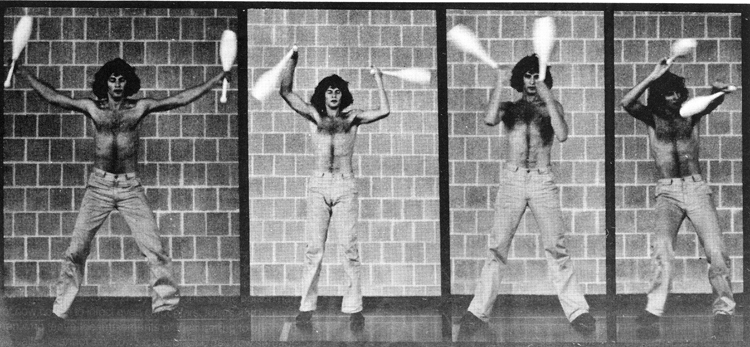
Allan Jacobs of Cambridge, MA, demonstrates club swinging maneuvers. |
Page 8 February 1980
|
Swingers
discover excitement in two-club twirl
Before
people juggled clubs, they swung them. The manipulation of three clubs
has roots in the late 19th and early 20th centuries when club
swinging, twirling one club simultaneosIy in each hand, was a popular
gymnastic exercise and competitive sport.
Largely
forgotten since the 1932 Olympics, when it was a part of the gymnastics
competition for the last time, several IJA members are now resurrecting
club swinging in their public performances.
Arthur
Furst, a former champion club swinger for Los Angeles City College, said
the stress of the exercise led to its downfall in the '30s. College
gymnasts who performed the required four minute club swinging routine
could rarely recover to effectively compete in the events that followed,
said the Palo Alto, CA, consultant to the World Health Organization.
Gymnastics competition, which also included rope climbing then,
Club
swinging uses two or three fingers on each hand (depending on the grip
employed) to anchor the round knob of a rapidly spinning club. With the
2 1/2 pound club of Furst's competitive days spinning like a propeller,
great effort was required to control and direct its centrifugal force.
Furst, who still swings daily for exercise, has built up 1/2 inch muscles
between his thumbs and forefingers from the years he has put into it.
The
2 1/2 pound club has largely been abandoned for lighter models by
current IJA club swingers. Other things have changed also. Today's
performers, like Allan Jacobs, Tim Furst (Arthur's son), Michael Moschen
and the Amazing Fantasy Jugglers, use club swinging as a stage dance
rather than rigid gymnastic exercise. During competition in days of
yore, club swingers were not allowed to move their bodies, only their
arms and hands. Today's enthusiasts are all over the stage, using body
motion to enhance the club motion.
Jacobs,
a member of the Boston-based group Slap Happy, explained that club
swingers grip the spherical knob of a club with either the first three
fingers (ball and socket grip)
The
mechanics of club swinging are difficult to communicate here. However,
several old books on the subject explain the techniques in detail. The
best are Club Swinging by William Schatz (1908), Manual of Instruction
in the Use of Dumb Bells, Indian Clubs and Other Exercises by M.
Bomstein (1880) and Indian Club Exercises and Drills by A.K. Jones
(1901).
Don
and Lana Reed and Rawd Holbrook, the Amazing Fantasy Jugglers, worked
eight months on a three-minute club swinging routine for their shows all
over New England.
With
all three on stage, they swing clubs in synchronized or staggered unison
to music. Six clubs going at once, Don reasoned, are more dynamic and
exciting than two.
Tim
Furst, one of the Flying Karamazov Brothers, swings clubs in his act,
too, but the audience might not be sure how he's creating the effect
seen. That's because Furst cuts out the house lights and swings two
light-emitting clubs that he
Michael
Moschen reportedly swings fire clubs, creating a visual effect similar
to Furst's. However, the fire obviously eliminates many of the
body-wrapping arm moves possible in the sport. Zeithen
writes juggling history Karl-Heinz
Zeithen has written a two-volume history of juggling to be published
in German, French and English. The first volume should be published in
March. Each book is about 300 pages long, including 250 photos. There
will also be information on specific juggling tricks. For information,
write Ziethen at Berlin, Germany. |

Allan Jacobs of Cambridge, MA, demonstrates club swinging maneuvers. |